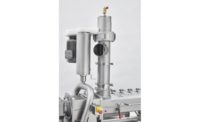
Today’s depositors must be versatile, precise and durable and be able to gently handle a variety of ingredients with almost seamless changeovers. In addition to multitasking, they even have to be multilingual as well.
With today’s fickle consumer combined with a constantly changing marketplace, nobody knows exactly what the next big trend or new hot product will be. Bakers need to be prepared to go into places and categories where they have never been in the past.
All too often, however, the barrier to entry into many new product categories can be determined by the versatility of a company’s equipment. Many times, the return on investment will determine if an innovative product comes to market. If the investment costs are too high, the risks may outweigh the reward.
That’s why bakers are looking for systems that can handle their production demands today, as well as those unexpected opportunities that pop up tomorrow, notes John McIsaac, vice president of strategic business development at Reiser, Canton, Mass.
“It seems almost daily they are looking to run new products, and they want to run multiple new products on a single piece of equipment. They also insist on precise portion control, beyond what standard gravity fed technology can deliver,” McIsaac explains. “We have seen an increase in machinery and attachment sales for organic, natural and vegan products. These are often very difficult to run and represent opportunity for our vacuum-based depositors. Gluten-free products, and the challenges they present, are also driving machinery sales. Customers no longer will adapt their recipes to their depositors. They are demanding that the depositor handle their products as they specify.”
In response to consumer trends, bakers also have been cranking out a flurry of individual desserts and smaller portion products that have a greater focus on quality and healthful ingredients, notes Luc Imberechts, president of Bakon USA Food Equipment, Torrance, Calif.
“The baking industry keeps creating products that are innovative,” he says. “The original designs, the combination of flavors and the introduction of new ingredients are endless once combined with the passion of the players. The trends have shown the importance of accuracy and flexibility in depositors. Small weight inconsistencies can have dramatic impact on the bottom lines once we talk about volume. Time spent in adjusting and cleaning the depositors is not time invested wisely.”
As a result of such innovation, when it comes to depositors, return on investment can be defined at least a dozen ways. In many cases, bakers are responding to consumer-driven trends with value-added products that incorporate premium, wholesome and healthful ingredients, notes Stewart Macpherson, vice president of sales and marketing at Unifiller, based in Delta, B.C., Canada.
“Bakers today are committed to producing products of a higher quality than ever before such as muffin or cake batters containing larger fruit, nut or chocolate inclusions,” Macpherson says. “This, in turn, emphasizes the increased importance of accurately portioning bakery products with depositors without changing the integrity of the formula, which is only possible if the equipment has been designed with this end result in mind. In the light of skyrocketing ingredient prices and increased shipping costs, we need to improve how we manufacture our bakery products today. A well-designed bakery depositor should offer the baker precise portion control, be simple to use and easy to clean, and thorough machine sanitation are increasingly important factors for today’s bakers.”
In addition, bakers are creating a wider variety of products using a new generation of inclusions, says Rick Hoskins, director of sales and marketing for Colborne Foodbotics, Lake Forest, Ill.
“The challenge is to find the depositors that can accurately portion these products in both weight and distribution,” he says. “We have taken our standard technology and enhanced its capability with pretty simple design revisions so customers can run a wider variety of inclusions through the same depositor at a cost-effective investment.”
To enhance operating efficiencies, Unifiller recently launched its fully computer-controlled, servo-driven multi-piston depositor along with a new “i-series” of single-piston depositors capable of making weight adjustments automatically when tied in to a check weighing load cell, Macpherson says.
“This means that when the consistency of the cake, batter, icing or filling changes during production, as it does frequently, the machine will automatically detect this and make the correction automatically by weight,” he explains.
It’s Precisely That
One of the chief challenges with depositing applications involves product giveaway associated with poor portion control that can be caused by deposit variances of some traditional piston depositors, says Andy Hovancik, general manager of The Peerless Group, Sidney, Ohio.
Piston depositors, he says, work by estimating deposit weights by liquid volume. As a result, the piston or volumetric depositor can produce a variance of weight depending on the application. When product weight is paramount, he adds, bakers tend to be biased toward depositing products toward the high side of the spectrum. The resulting product giveaway, Hovancik says, increases food costs and ultimately takes from bakers’ bottom lines.
“Our solution is to replace volumetric scaling with mass flow metering technology,” he says. “The Peerless mass flow metering and independent scaling system provides greater accuracy. In one case, the Precision Depositor helped a high-volume baker achieve accuracy 10 times greater than traditional piston depositors.”
To meet bakers’ demands in today’s environment, companies like Hinds-Bock find themselves doing more engineering than ever, says Lance Aasness, vice president with the Bothell, Wash.-based company.
“It’s not just the depositor, but integrating it into the customers’ plant and integrating it with upstream and downstream equipment,” he explains.
Aasness notes that the go-go days are over. That’s when bakeries had bulked-up engineering and maintenance staffs that could handle almost any situation and oversee the start up of lines from beginning to end.
Today, he adds, “every business is forced to run in such a way that they’re controlling their costs and maximizing their profits to the best of their ability, and bakeries are no different. They have paper-thin engineering staffs, and even if they contract with one of the big engineering companies.”
As a result, bakers are relying more on the expertise of their suppliers.
“That’s where companies like Hinds-Bock will go in and design a depositing line using 3-D CAD [computer-aided design] software to integrate with bakers’ existing equipment such as conveyors, ovens, pan groupers or freezers,” Aasness says.
Hinds-Bock also uses Web-based engineering reviews where bakers can get involved in the design phase of the depositor and put their fingerprint on how it operates and is sanitized and maintained.
Some companies such as Bakon offer on-line support through a modem connection on the gearwheel depositors. This allows for fast troubleshooting or program changes resulting from change in demand, Imberechts notes.
Ease of Sanitation
Although always an issue, sanitation now has emerged as the Top 2 or 3 item on Colborne Foodbotic’s customers’ lists, Hoskins notes. In response, the company’s systems can now be disassembled in five minutes or less with no tools.
Sanitation is so critical, McIsaac adds, that many bakers will pay for depositors that can help them lower their risk, especially as it relates to allergens.
For bakers who run multiple products daily, the focus has been on reducing the necessary time it takes to changeover, clean and calibrate depositors between products to enhance operational efficiencies, Hovancik says. To streamline product changes, Peerless adds a programmable recipe control and a closed loop, clean-in-place system that requires no disassembly to speed up the sanitation process.
Labor issues remain a top concern for many bakers, Macpherson says. Integrating depositors into lines can solve such problems as labor shortages, lower labor costs, reduce employee training and increase quality control.
Programmable controls seem to be, at least, a partial solution for the industry’s skilled labor shortage, Imberechts says.
“The industry is sensitive to fast start-up of new equipment, short training time; the machines need to be user friendly,” he notes. “In this context, PLC controls allow for a centralized, multilingual, easy operation of the machine.”
With Reiser, language is no barrier for companies with diverse workforces.
“We have multilingual capability available at the touch of a button,” McIsaac notes. “We have some installations where customers change language on the Vemag at shift change.”
With bakers facing numerous challenges in today’s competitive environment, the advances in technology continue to provide solutions that are exactly on target.
*Photo courtesy of Reiser


